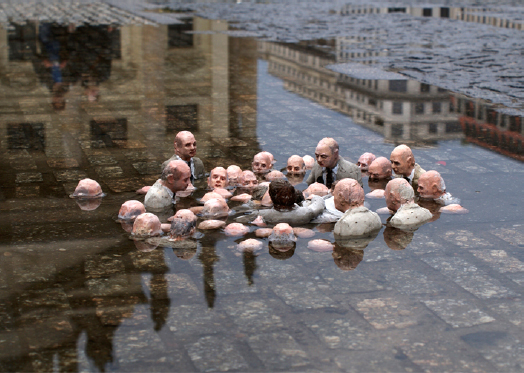
Visualizing Climate Change
Artists often use their art not only to depict beauty and express feelings, but also to make statements and share viewpoints. Art can be critical, educational, analytical, interpretive, or symbolic, and frequently a combination of more than one of these. Two artists choose to use their art to educate their audience about the threats of climate change by making the effects of such change tangible, visible and dramatic.
Isaac Cordal
Isaac Cordal uses miniature sculptures to show the effects of climate and environmental change. His work is often installed as site-specific streetscapes, similar to street guerrilla art. Through careful placement, his work shows pedestrians the precarious nature of human existence.
Waiting for Climate Change
In his series 'Waiting for Climate Change', Cordal created a set of ephemeral and partially submerged installations to draw attention to rising sea level change. These apocalyptic scenes show rising floodwaters and drowning people, and remind the audience that inaction and apathy can have horrific consequences. The themes of flooding and drowning are repeated throughout the series to reference both climate change and the state of our sinking society.
Follow the Leaders
In another installation entitled 'Follow the Leaders', Cordal created identical statues in the likeness of middle-aged, white-collar, white men, each desperately clutching a briefcase as they huddle together or drown to death. This grim picture warns the audience of the dangers in blindly following the rich and the powerful. Again, Cordal tackles big political issues through small miniature figurines.

In Cement Eclipses, men and women are suspected and isolated in a motion or pose that can take on multiple meanings. The precariousness of these miniature people represents the devaluation of humans in relation to nature. Like the people that blindly follow business leaders and politicians in Follow the Leader, ordinary people can easily be swept up by the forces of nature as well.

Jason deCaires Taylor
Jason deCaires Taylor is an English sculptor who specialises in the creation of underwater sculptures. Like Cordal streetscapes, Taylor's seascapes make real the effects of climate change to the audience. Unlike Cordal who uses miniature figurines, Taylor's representations are life-sized.
Nature reclaiming the human environment
The thirty-nine-year-old Taylor, grew up in Malaysia, and spent his childhood exploring the reefs and islands that populated his local habitat. Eventually, his family moved back to the U.K. While searching abandoned factories and dilapidated railway lines in the U.K., he continued to dream of the aquatic invasions of coral reefs. He eventually became interested in the way that nature reclaims human environments.
Grenada
In 2006, Taylor began installing his first major underwater construction in Grenada. The installation consists of 65 sculptures each weighing 6,000 kg and covers an area of 800 square metres. Accompanied by a guide, viewers can snorkel or scuba dive to the sculptures for an up-close look. For those who prefer to stay dry, glass bottom viewing boats are also a popular option.
The Grenada installation is listed as National Geographic's Top 25 Wonders of the World. But its positive ecological impact far outweighs its aesthetic design. The area has suffered considerable storm damage over the years and the placement of an artificial, pH-neutral sculpture has at the same time provided a new base for new marine life to grow and diverted tourists away from natural reefs that are suffering from environmental distress.

MUSA
Taylor's most ambitious project to date is the creation of the world's largest underwater sculpture museum Museo Subacu'atico de Arte (MUSA), located off the coast of Cancun and the western coast of Isla Mujere in Mexico. The project began in 2009 and consists of over 450 permanent life-size sculptures. The museum aims to demonstrate the interaction between art and environmental science. Each of the sculptures is made from specialised materials used to promote coral life. In an article in Diver Magazine, Taylor explains the intention of his work, by stating 'I believe they promote hope and recovery, and underscore our need to understand and protect the natural world.'
Siu Wai-hang, Master of Fine Arts graduate of the CUHK Department of Fine Arts, won the WYNG Masters Award, which aims at raising social awareness through photography. The theme was 'air'. Siu's subjects were plants in landfills, container terminals and by the roadside, which breathe the same air as Hong Kongers everyday. The wilting plants are a symbol of Hong Kong's exacerbating air pollution problem.


